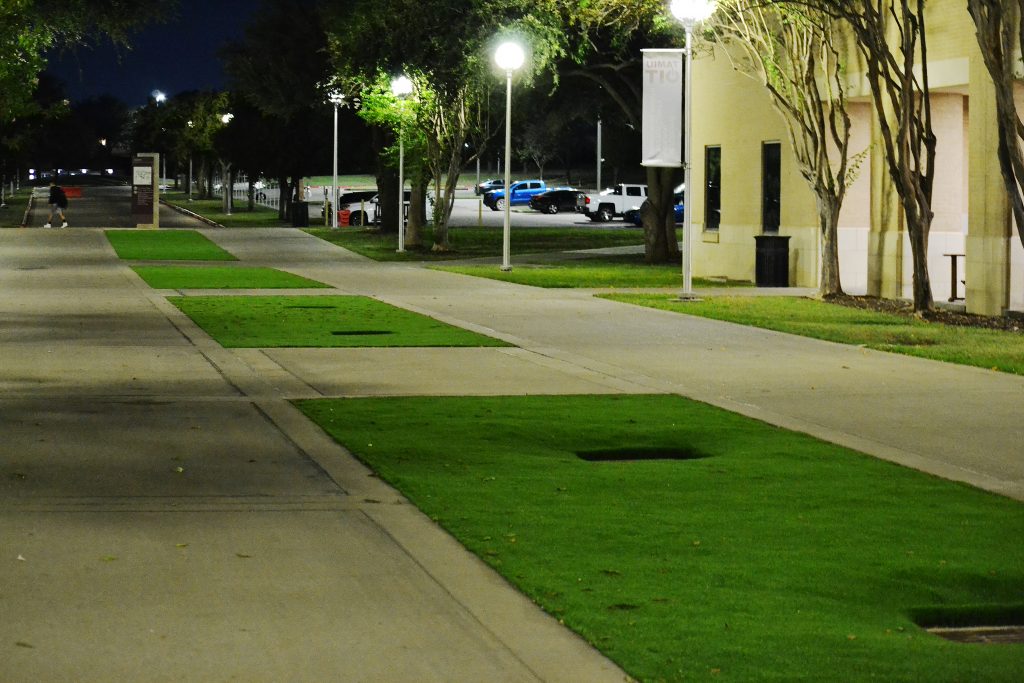NEWS: Campus switches grass portions to artificial turf
By Joycce Morales Banales
Bridge Contributing Writer
Published Tuesday, Oct. 8, 2024
Near the start of the Fall 2024 semester, TAMIU changed several sections of grass on campus, mostly around the quad.
Senior Director of Campus Safety and Planning Trevor Liddle oversees campus beautification efforts, such as landscaping. Liddle said the current change is the first test of a bigger plan for the outdoor campus spaces.

A row of green artificial turf stretches into the night on Oct. 1 between the Sue and Radcliffe Killam Library and Dr. Billy F. Cowart Hall.
As Texas A&M International University continues to grow, there are limited opportunities for landscaping these smaller areas, making them ideal for the first test.
Later, additional tests are planned to include other areas to provide more space for outdoor student programming. This change is expected to help with water conservation and reduce maintenance costs.
“[It] esthetically improves the look of the campus for the overall enjoyment of not only students but everybody who comes to campus to visit us,” Liddle said.
As some have noticed, grass is sprouting up in parts of the artificial turf.
“[We’ll manage it] the good old-fashioned way,” Liddle said. “… and part is the proactive management using selected herbicides and other chemical treatments.”
However, this type of growth will require low maintenance compared to the high maintenance demanded by natural grass.
Despite plans to convert more areas to artificial turf, the master plan intentionally designs some campus areas to remain natural zones, such as the grass areas in front of the Sue and Radcliffe Killam Library. Liddle emphasized the importance of the natural environment, stating it is crucial not only to the actual environment but also to the heartbeat of the campus.
“What we have is very limited, and apart from that, TAMIU has always been proud of the animals,” TAMIU psychology graduate Estefania Hernandez said. “They are part of TAMIU. They are a symbol that in this University there exists more than student bodies.”
With these changes, some of the TAMIU community is concerned the wildlife will be seen less on campus.
“Because they’re not going to have the food on campus they normally would,” Associate Professor of biology Monica O. Mendez said, “they might stay on the edges.”
TAMIU regularly encourages visitors and students to leave wild animals alone, sometimes through signage.
“We’re looking at these types of applications as a way to minimize the impact on the natural world while maximizing the impact for personal safety,” Liddle said.
Due to an incident with a deer back in 2022, this change could bring improved safety at TAMIU.
Artificial turf material will eventually break down into microplastics, affecting the soil underneath the turf. The soil will be the most impacted by the change.
“[This affects] the normal breakdown of organics in that soil, and the probability the soil microbial community in that spot are going to change, and then all the soil organisms, like all the good invertebrates that are in there,” Mendez said.
The natural aspects of TAMIU attract people and allow them to free themselves a little bit from the dryness seen in the streets of Laredo.
“Nature demonstrates a positive aspect for the students, so they continue coming and feel like they are in another area distinct from Laredo,” Hernandez explained. “I understand TAMIU does it for everyone’s well-being because who doesn’t like to come and see a place full of life? … green transmits life, and it is understandable that this is done in a good way for everyone to come.”
This change, even though unnatural, will always offer a fresh, green look to campus.
With time, the eye will adapt to the artificial turf color as students have adapted to TAMIU’s nature and wildlife.
Meanwhile, the administration is optimistic these changes will enhance the campus experience for students, staff and wildlife alike. Liddle emphasized that the University remains committed to balancing development with sustainability, ensuring that TAMIU remains a vibrant and welcoming environment.
